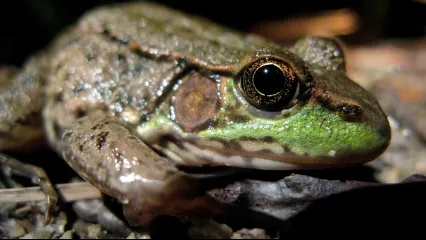
Description
Dark-sided salamanders are moderately small, thin-bodied salamanders with broad heads, large eyes, and relatively long legs. The background color is yellow to orange and the body, tail, and legs are covered with irregular black markings. The lower sides of the body are white with black markings. Black markings along the sides of the body where the background color changes from yellow or orange to white form an irregular black stripe that extends from the eye, down the side of the body, and down the tail. In addition, the head is relatively large and the eyes protrude well above the head. The thin tail is considerably longer than the body and is slightly compressed laterally in cross section. Dark-sided salamanders have 13 to 14 costal grooves.
The cave salamander could be confused with the dark-sided salamander, but is usually red or orange with black spots.
Size
Dark-sided salamanders can reach up to 6.5 inches in total length, but most individuals vary from 4 to 6 inches in total length.
Habitat
The distribution of dark-sided salamanders in North America extends west to east from northeastern Oklahoma across most of the eastern United States and north to south from at least New York to the coastal plain of Alabama and Mississippi. Populations outside of the Ozark region are considered to be a separate subspecies.
Life Cycle
Dark-sided salamanders live in crevices in fractured limestone and under rocks along clear streams and springs. Females deposit clutches of eggs in pools of water in limestone caves and fissures from December through March. The aquatic larvae usually follow trickles of water out of caves and live in clear pools on the surface where more food is available. Overall, the natural history of this species is poorly known.
This salamander feeds on small insects and spiders.
How To Observe
Dark-sided salamanders can be found relatively easily by turning rocks along clear streams or by carefully lifting cap rocks on limestone outcrops, especially in spring when it is relatively wet. They can be found at night by searching along crevices in limestone outcrops or near clear streams with a good headlight.
(This profile was created by Dr. Laurie Vitt as part of a partnership between the Wildlife Department and the Sam Noble Oklahoma Museum of Natural History. It was funded as part of a larger State Wildlife Grant to survey and inventory amphibians and reptiles of the Wildlife Management Areas of Oklahoma: T-35-P-1.)


